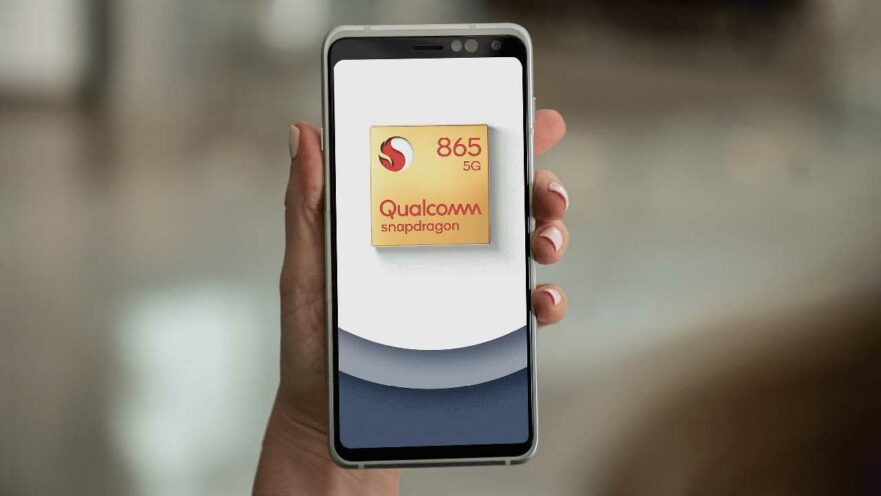Newer processors are designed to beat its predecessors, but there was an outlier last year that raised doubts. The Qualcomm Snapdragon 855 processor couldn’t defeat the earlier launched Apple A12 Bionic processor. So, we wonder if the upcoming Snapdragon 865 will suffer the same fate against Apple’s current A13 Bionic chipset.
Antutu and a few online technology publications have shared benchmark results of the new Qualcomm chipset.
If we think about this in terms of the devices the processors are powering or will power, then we think of the upcoming Samsung Galaxy S11 lineup and the current Apple iPhone 11 series. The former is expected to launch with the Snapdragon 865 in markets where Samsung won’t equip the phones with its Exynos processor, while the latter runs on the A13 Bionic chip.
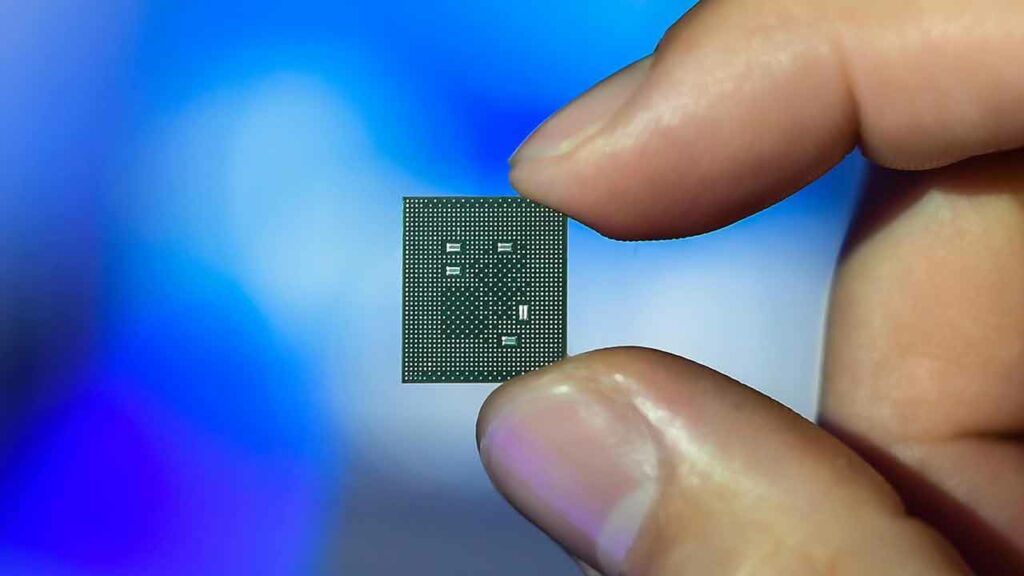
Qualcomm Snapdragon 865 chip
The results give us high hopes for the Samsung flagship to overtake Apple’s premium handset — at least until the latter releases its next processor.
Qualcomm promises the Snapdragon 865 offers 25% better CPU performance and a 20% increase in GPU performance over the previous-generation Snapdragon 855. The new mobile system-on-chip will also support LPDDR5 memory and comes with a newer 7nm process. But how does this translate? See the Antutu results and those of tests ran by three sites: TechRadar, PCWorld, and XDA Developers.
Snapdragon 865 vs Snapdragon 855 Plus (5G), Kirin 990 5G, and MediaTek Dimensity 1000
In Antutu’s comparison, the Snapdragon 865 scored considerably higher than the Snapdragon 855 Plus in the Vivo NEX 3 5G, the Kirin 990 5G in the Huawei Mate 30 Pro 5G, and the MediaTek Dimensity 1000 in a reference device.
Using a unit with a 2,880 x 1,440 screen, 12GB RAM, 64GB storage, and Android 10, the Snapdragon 865 posted 568,919 points.
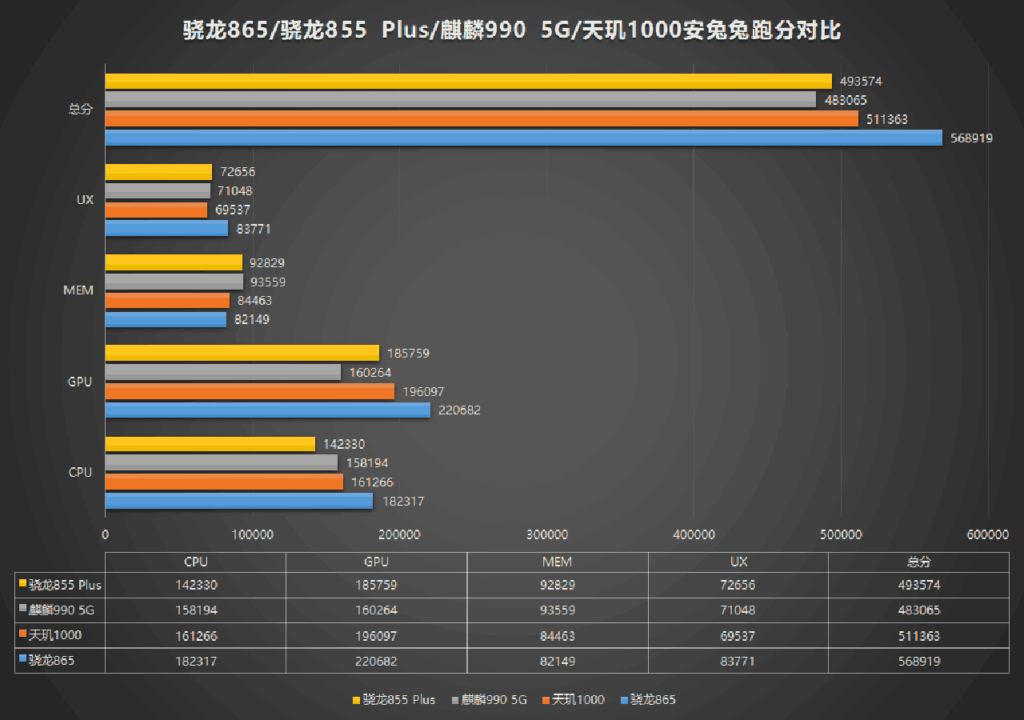
Qualcomm Snapdragon 855 Plus vs Kirin 990 5G vs MediaTek Dimensity 1000 vs Qualcomm Snapdragon 865. The 865 got the highest overall score of 568,919
TechRadar
Qualcomm let TechRadar test a Snapdragon 865-loaded reference device against the Apple iPhone 11 Pro Max. The unit features hardware specs you can expect to hear a lot from Android flagships in 2020: a Quad HD+ display with a 2,880 x 1,440 resolution, 12GB of LP5 dual-rank RAM, an octa-core processor, and 128GB of internal storage.
The online publication put it to the test using benchmark apps Antutu, Geekbench, and GFxBench. The results of their testing showed the Snapdragon 865 outpacing Apple’s A13 Bionic processor in some crucial areas.
SEE ALSO: Antutu’s best-performing flagship, midrange phones for Nov 2019
Geekbench — which offers multi-core score assessment — showed that the Snapdragon 865 could outpace the Apple A13 Bionic chipset when it comes to handling complex workloads. The Snapdragon 865 got 3,450 over the iPhone 11 Pro Max’s multi-core score of 3,337. Having a higher rating means the Snapdragon 865 can pull off tasks like video rendering, 3D gaming, and image processing better.
When it comes to the single-core score, the Snapdragon chip trailed Apple’s processor, though the former got a 931 on Geekbench 5 over the latter’s 1,331. The single-core compute score shows the processor’s capabilities for simple tasks like mobile web browsing.
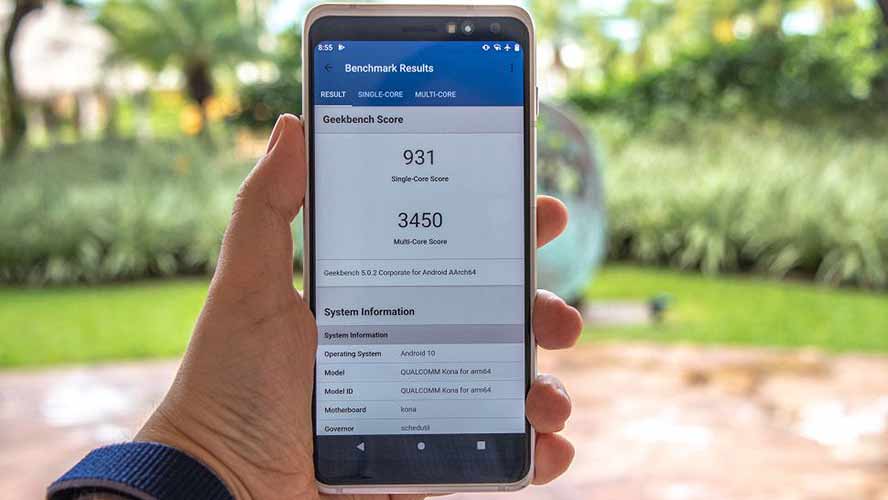
Qualcomm Snapdragon 865’s Geekbench benchmark scores in a test conducted by TechRadar
Qualcomm is admittedly putting more emphasis on multi-core score, GPU, and AI chips, so the result isn’t that surprising. The focus on spreading out the workload to more cores might work in Qualcomm’s favor as developers do the same for the applications they create.
To test these features, TechRadar used apps like GFxBench and Antutu for GPU benchmarks and AITutu and Ludashi AI Mark for newer AI tests. The scores the Snapdragon 865 garnered met or exceeded what Qualcomm had as its “expected” score range.
After three consecutive tests in each app, the pre-installed GFxBench Manhattan offscreen test gave the chipset a score of 89, Antutu’s GPU test garnered a 221,435 rating, Ludashi AI Mark exceeded 100K at 105,072, and AITuTu reached 455,235.
PCWorld
PCWorld‘s tests tried using both the default and the performance mode, which sped up the chipset while draining the battery a bit faster. The publication pitted the Snapdragon 865 against the Snapdragon 855, Snapdragon 855 Plus, and Apple A13 Bionic processors.
Their Geekbench test results were consistent with TechRadar‘s. The Snapdragon 865 was at its best in the multi-core test, having it perform 30% better than the Snapdragon 855-powered Samsung Galaxy S10 Plus, though only 2% better than the Snapdragon 855 Plus in a OnePlus 7T. Meanwhile, its single-core performance falls below the Snapdragon 855 Plus.
Trying the processor with PCMark’s Work 2.0 benchmark, the Snapdragon 865 emerged victorious over the past Snapdragon processors. But it didn’t lead by much. With its performance mode activated, the Snapdragon 865 scored 12,217, while the Snapdragon 855 came in relatively close at 10,863. Work 2.0 doesn’t work on iOS, so they weren’t able to test this.
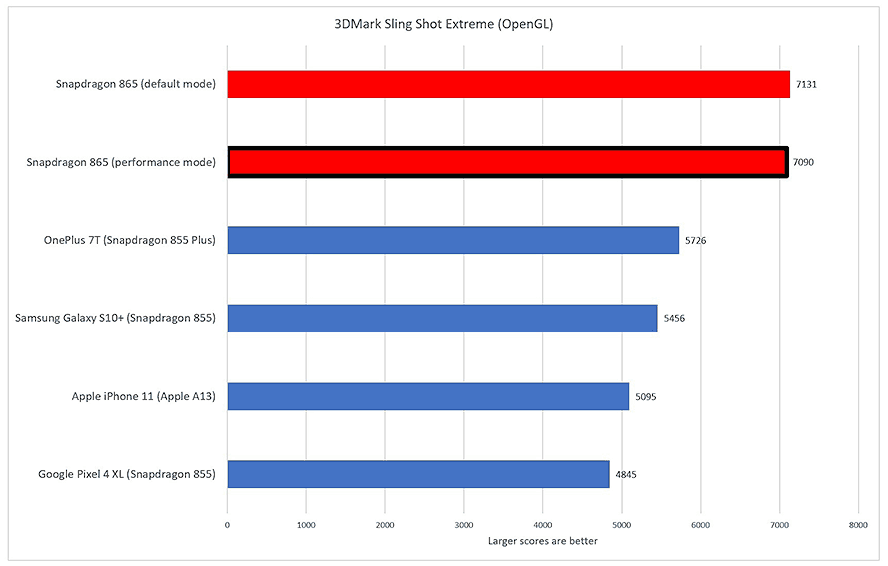
Results in 3DMark’s Sling Shot Extreme benchmark
The Snapdragon 865 shows that it can deliver when it comes to 3D performance, an essential feature with more PC games getting ported to smartphones. PCWorld used 3DMark’s Sling Shot Extreme benchmark to see how well the Snapdragon 865’s Adreno GPU core performs. In both default and performance modes, the Snapdragon 865 scored 7,131 and 7,090, respectively. The closest second was the Snapdragon 855 Plus at 5,726.
XDA Developers
XDA Developers compared the new system-on-chip with Qualcomm’s Snapdragon 855 Plus, Snapdragon 855, and Snapdragon 845 and Huawei’s Kirin 990.
Some of the results were also consistent with what the other publications saw: the Snapdragon 865 exceeding or, at the very least, meeting Qualcomm’s expected performance gains.
The site’s Antutu test saw a 33% performance increase over the Snapdragon 855 Plus and a 45% performance increase over the Snapdragon 855. Both results exceeded Qualcomm’s claims of offering 25% CPU performance gain for the processor.
READ ALSO: Launched: Redmi K30 models headlined by cheapest 5G phone
Meanwhile, GPU performance increase was a bit more restrained, with the average around 13% when compared with the 855 Plus or between 24% and 56% when compared with the 855.
As for PCMark 2.0 scores, there was a 40% leap in the Work 2.0 final scores when compared with the Snapdragon 855 Plus’. XDA Developers noted the most significant improvement was in the Photo Editing 2.0 subtest, where the score nearly doubled, and then followed by a Web Browsing score improvement of about 80%. The other results were more conservative at less than 25%.
Their 3DMark tests achieved scores that fell more or less in line with the 20% expected faster graphics rendering, while the GFXBench scores showed a boost of around 5% to 15% over the Snapdragon 855 Plus and over 20% increase over the Snapdragon 855.
So, what do these mean?
You can expect powerful graphics and AI performance from the 2020 Android flagships. The handsets, like the Samsung Galaxy S11 models, will be ready to take on resource-heavy apps and tasks with ease, which will always be a win in our book.
But we need to remind you that the tests were performed on Qualcomm-provided devices, which means they meet a specific set of metrics set by the chipmaker. The performance of the Snapdragon 865 will still vary when the processor is placed in a device made by third-party manufacturers. One thing we’re sure of is we can’t wait to test it.
Share this Post

